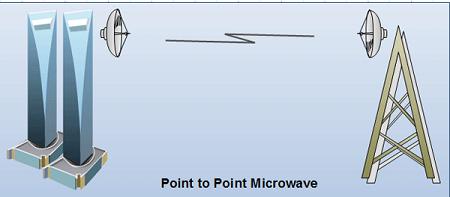Microwave radio, a form of radio transmission that use. Ultra-high frequencies developed out of experiments with radar (radio detecting and ranging) during the period preceding World War II. There are several frequency ranges assigned to microwave systems, all of which are in the Giga Hertz (GHz) range and the wavelength in the millimeter range. This very short wavelength gives rise to the term microwave. Such high frequency signals are especially susceptible to attenuation and, therefore must be amplified or repeated after a particular distance.
In order to maximize the strength of such a high frequency signal and, therefore, to increase the distance of transmission at acceptable levels, the radio beams are highly focused. The transmit antenna is centered in a concave, reflective metal dish which serves to focus the radio beam with maximum effect on the receiving antenna, as illustrated in Figure. The receiving antenna, similarly, is centered in a .concave metal dish, which serves to collect the maximum amount of incoming signal.
 It is a point-to-point, rather than a broadcast, transmission system. Additionally, each antenna must be within line of sight of the next antenna. Given the curvature of the earth, and the obvious problems of transmitting through it, microwave hops generally are limited to 50 miles (80 km). If the frequencies are higher within the microwave band given in Table 2.1, this impact is more than lower frequencies in the same band.
It is a point-to-point, rather than a broadcast, transmission system. Additionally, each antenna must be within line of sight of the next antenna. Given the curvature of the earth, and the obvious problems of transmitting through it, microwave hops generally are limited to 50 miles (80 km). If the frequencies are higher within the microwave band given in Table 2.1, this impact is more than lower frequencies in the same band.
Frequency Bands Maximum Antenna Separation Analog/Digital 4-6 GHz 32-48 km Analog 10-12 GHz 16-24 km Digital 18-23 GHz 8-11 km Digital.
General Properties of Microwave Transmission
Configuration Microwave radio consists of antennae centered within reflective dishes that are attached to structures such as towers or buildings. Cables connect the antennae to the actual transmit (receive) equipment.
Bandwidth Microwave offers substantial bandwidth, often in excess of 6 Gbps.
Error Performance Microwave, especially digital microwave, performs well in this regard, assuming proper design. However, such high frequency radio is particularly susceptible to environmental interference, e.g. precipitation, haze, smog, and smoke. Generally speaking, however, microwave performs well in this regard.
Distance Microwave clearly is distance limited, especially at the higher frequencies. This limitation can be mitigated through special and more complex arrays of antennae incorporating spatial diversity in order to collect more signals.
Security As is the case with all radio systems, microwave is inherently not secure. Security must be imposed through encryption (scrambling) of the signal.
Cost The acquisition, deployment and rearrangement cost of microwave can be high. However, it often compares very favorably with cabled systems, which require right-of-way, trenching, conduit, splicing, etc.
Applications Microwave originally was used for long haul voice and data communications. Competing long distance carriers, microwave was found the most attractive alternative to cabled systems, due to the speed and low cost qf deployment where feasible, however, fiber optic technology is currently used in this regard. Contemporary applications include private networks, interconnection of cellular radio switches, and as an alternative to cabled systems in consideration of difficult terrain.
 Dinesh Thakur holds an B.C.A, MCDBA, MCSD certifications. Dinesh authors the hugely popular
Dinesh Thakur holds an B.C.A, MCDBA, MCSD certifications. Dinesh authors the hugely popular